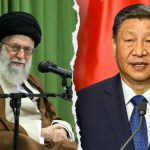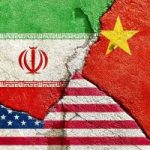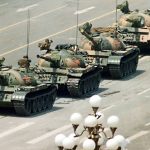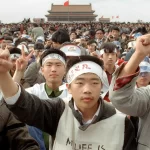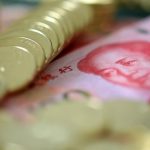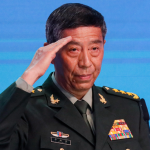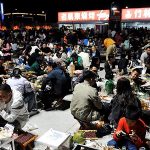BY LIANCHAO HAN AND BRADLEY A. THAYER
As Western audiences are distracted by the aftermath of the U.S. withdrawal from Afghanistan, China’s expansion continues like a metastasizing cancer, almost imperceptibly. China increasingly represents a threat to its neighbors, the United States, and the liberal world order.
China’s leaders understand how to hide their aggression, using Western concepts, terms and concerns. Near the end of August, China’s Maritime Safety Administration announced a requirement (which took effect Sept. 1) for foreign military and commercial vessels — submersibles and surface — that carry radioactive material, chemicals, bulk oil, liquified natural gas or other toxic or dangerous materials, to report their presence and cargo deadweight to Chinese maritime traffic safety authorities when entering and leaving China’s jurisdictional waters.
Moreover, vessels that may endanger the maritime safety of China, as determined by China’s laws and provisions of the State Council, also must report. This requirement has the potential to disrupt maritime traffic through the East and South China Seas, and thus global shipping, maritime law and the United Nations Convention on the Law of the Sea (UNCLOS). The strategic interests of the United States, Japan, India, Taiwan and South Korea, as well as the states of the South China Sea littoral, are threatened.
More significant is an archetypical case of China’s territorial expansion. As China has done before, such as with its 2013 Air Defense Identification Zone (ADIZ) unilateral decision, there are three key steps. First, China issues rules and requirements in the interest of maritime or aviation safety. Second, states alter their accepted behavior to adhere to these rules and they become accepted, with the excuse provided that the action is a small measure taken by China to improve safety. Third, China’s de facto control is recognized. Once control is achieved, the regulations are tightened and soon China exercises control, backed by its military, to police its new territory.
This is a significant change from what Beijing has done in the past.
The history of the People’s Republic of China is one of expansion, yet under Mao Zedong and Deng Xiaoping, expansion was coercive; China employed military power to do so. The People’s Republic was only a year old when it invaded Tibet, contemplated an invasion of Taiwan, and attempted to unify the Korean peninsula by attacking United Nations forces. Tibet was finally crushed in 1959 and China’s Sinification of the territory may ensure that it never is independent. The same process is under way in Xinjiang against the Kazakh, Kyrgyz and Uyghur Muslim minority.
China launched a war against India in 1962, clashed again in 1967 and at other times before the recent clashes along the Sino-Indian border, including at Doklam in 2020. China even clashed with the Soviets along their shared border in 1969. China aided North Vietnam during the war, including manning anti-aircraft artillery firing at U.S. aircraft, and aggressed against the South Vietnam-controlled Paracel Islands in 1974. Later, it did so against a unified communist Vietnam in 1979 and 1988 — China’s erstwhile ally, whose relationship Mao once described as being as close to the PRC “as lips and teeth.” This form of direct expansion led to significant resistance to China, including wars with the U.S. in Korea and indirectly in Vietnam, and a near conflict with the Soviet Union.
Today, China’s expansion is more subtle — and more effective. China’s market and economic might, largely funded by U.S. capital markets, provide China with the ability to manufacture the world’s products and to trade, invest in and build infrastructure worldwide. China’s growing scientific prowess allows it to expand its reach in space, with lunar and planetary exploration, and in the Arctic, subarctic and Antarctica. Its universities are growing into world-class centers of academic research and pedagogy beyond the natural sciences and engineering, with fine arts and social sciences.
But perhaps China has been most adept at expanding its borders without generating effective resistance from a single state or coalition to defeat it. Nowhere has China’s strategy been more successful, perhaps, than in the East and South China Seas. The economic interests appear first, accompanied by civilian authority to police, and rules and regulations that must be followed in the interests of safety, which then segues into military presence and complete sovereign control. The strategy has been effective so long because the U.S. and its allies do not reverse it.
In fact, this is precisely what the United States must do. The U.S. must act as China’s unilateral changes to international law and accepted practices reshape world order. The West cannot allow this to stand. Forging a coalition of nations who refuse to submit to China’s action is a necessary first step, but it must be enforced because Beijing will place pressure on countries and firms to yield if they want to continue to do business with China. The U.S. must have a ready response to Beijing’s inevitable counters and enticements to yield to its actions. This includes the necessity of the U.S. to convince its allies and partners that it has the ability and willpower to stay the course.
China has been able to change the status quo at little or no cost. This encourages the scope and pace of its aggression. The Biden administration must develop a comprehensive strategy to counter China’s aggression that defeats Beijing’s strategy of purportedly supporting international law and order while actually destroying them.
This article first appeared in The Hill on 09/07/21 2:30 PM ET





